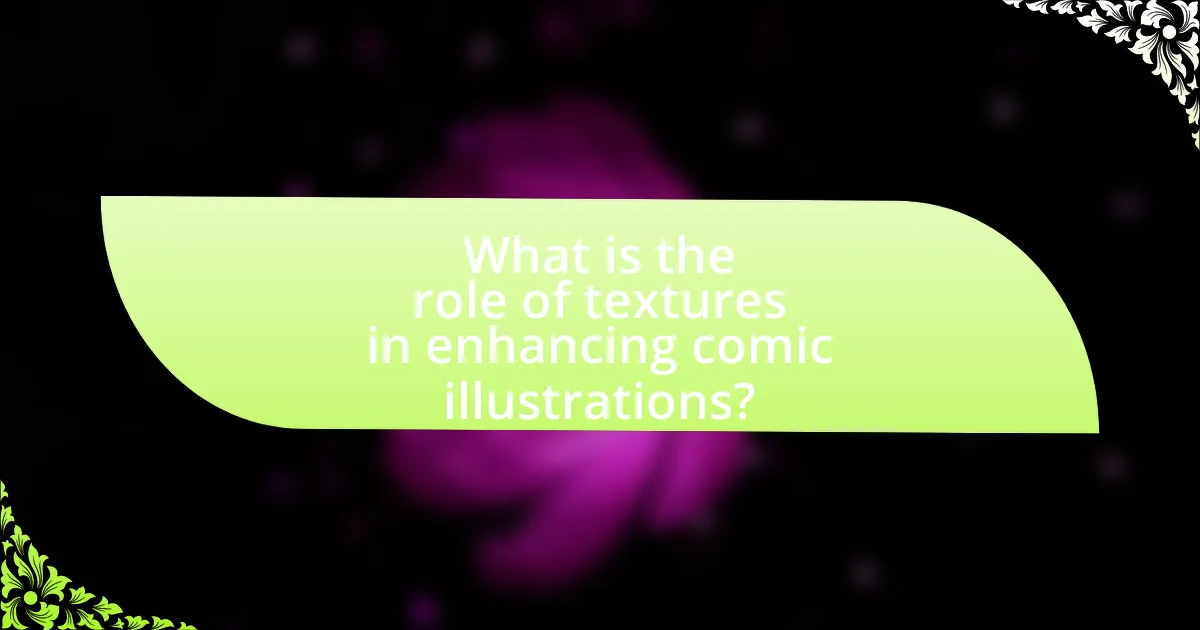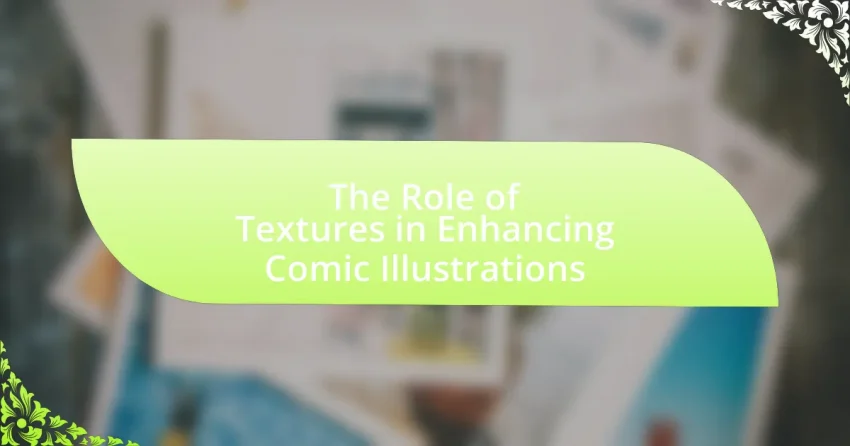The article examines the critical role of textures in enhancing comic illustrations, highlighting how they contribute to depth, dimension, and emotional resonance within the artwork. It discusses various types of textures, such as cross-hatching and stippling, and their impact on mood, character development, and storytelling. Additionally, the article addresses the techniques artists can employ to create dynamic textures, the challenges they may face, and best practices for integrating textures effectively. Overall, it emphasizes the importance of textures in shaping reader perception and engagement in visual narratives.

What is the role of textures in enhancing comic illustrations?
Textures play a crucial role in enhancing comic illustrations by adding depth, dimension, and emotional resonance to the artwork. They help to differentiate elements within a scene, guiding the reader’s eye and creating a more immersive experience. For instance, rough textures can convey tension or chaos, while smooth textures may evoke calmness or serenity. The use of textures also aids in establishing the mood and atmosphere of a comic, as seen in various styles ranging from gritty urban settings to whimsical fantasy worlds. This application of textures is supported by studies in visual perception, which indicate that textured surfaces can significantly influence emotional responses and engagement levels in visual storytelling.
How do textures contribute to the overall aesthetic of comic illustrations?
Textures significantly enhance the overall aesthetic of comic illustrations by adding depth, dimension, and emotional resonance. They create visual interest and can convey different moods or themes, such as rough textures suggesting tension or smooth textures indicating calmness. For instance, the use of cross-hatching or stippling can evoke a sense of realism or drama, while flat colors may create a more whimsical or simplistic feel. Studies in visual perception indicate that textures can influence how viewers interpret scenes, enhancing engagement and emotional response. Thus, the strategic application of textures in comic art not only beautifies the illustrations but also enriches storytelling by guiding viewer interpretation and emotional connection.
What types of textures are commonly used in comic illustrations?
Comic illustrations commonly utilize textures such as cross-hatching, stippling, and digital patterns. Cross-hatching involves creating shading and depth through intersecting lines, while stippling uses dots to achieve a similar effect. Digital patterns, often created with software, can simulate various materials and surfaces, enhancing the visual appeal of the artwork. These textures contribute to the overall mood and atmosphere of the comic, making scenes more dynamic and engaging for readers.
How do different textures evoke specific emotions in readers?
Different textures in comic illustrations evoke specific emotions in readers by creating visual cues that influence perception and mood. For instance, rough textures can convey tension or chaos, while smooth textures often suggest calmness or serenity. Research indicates that texture can significantly affect emotional responses; a study published in the journal “Psychological Science” by authors such as Hagtvedt and Brasel found that tactile imagery, including texture, can enhance emotional engagement with visual art. This demonstrates that the choice of texture is not merely aesthetic but plays a crucial role in shaping the emotional landscape of the narrative.
Why are textures important for storytelling in comics?
Textures are important for storytelling in comics because they enhance the emotional depth and visual narrative of the artwork. By using various textures, artists can convey mood, differentiate settings, and emphasize character emotions, which enriches the reader’s experience. For instance, rough textures can evoke feelings of tension or conflict, while smooth textures may suggest calmness or serenity. This use of texture aligns with the principles of visual storytelling, where the interplay of different elements contributes to a cohesive narrative. Studies in visual communication highlight that texture influences perception and emotional response, reinforcing the idea that textures are a critical component in effectively conveying stories in comics.
How do textures help in character development within comic narratives?
Textures significantly enhance character development within comic narratives by visually conveying emotions, personality traits, and backgrounds. For instance, rough textures can suggest a character’s toughness or resilience, while smooth textures may indicate sophistication or gentleness. This visual differentiation allows readers to quickly grasp the essence of a character without extensive exposition. Additionally, the use of textures can reflect a character’s journey; for example, a character may start with a clean, polished appearance that becomes increasingly worn and textured as they face challenges, symbolizing growth or struggle. This method of visual storytelling is supported by studies in visual communication, which indicate that texture influences emotional perception and character relatability in illustrated media.
What role do textures play in setting the mood of a comic scene?
Textures play a crucial role in setting the mood of a comic scene by influencing the emotional tone and atmosphere conveyed to the reader. For instance, rough textures can evoke feelings of chaos or tension, while smooth textures often suggest calmness or serenity. The use of varying textures can also enhance the visual storytelling by guiding the reader’s emotional response; for example, gritty textures may be employed in darker, more dramatic scenes to amplify a sense of danger or urgency. This technique is supported by studies in visual perception, which indicate that texture can significantly affect emotional interpretation in visual media.
How can textures influence the reader’s perception of action in comics?
Textures significantly influence the reader’s perception of action in comics by enhancing the emotional and physical intensity of scenes. For instance, rough textures can convey chaos or aggression, while smooth textures may suggest calmness or fluidity. Research indicates that visual textures can evoke specific emotional responses, impacting how readers interpret the dynamics of movement and energy within a panel. A study by McCloud in “Understanding Comics” emphasizes that textures contribute to the overall atmosphere, guiding the reader’s emotional engagement and interpretation of the action depicted. Thus, the strategic use of textures in comic illustrations is crucial for shaping the reader’s experience and understanding of the narrative’s action.
What techniques can artists use to create dynamic textures for action sequences?
Artists can use techniques such as layering, cross-hatching, and digital brushes to create dynamic textures for action sequences. Layering involves applying multiple transparent layers of color and texture to build depth and complexity, enhancing the visual impact of movement. Cross-hatching, a traditional technique, utilizes intersecting lines to create shading and texture, effectively conveying motion and energy in action scenes. Additionally, digital brushes in software like Adobe Photoshop allow artists to simulate various textures, such as splatter or rough surfaces, which can add realism and excitement to the artwork. These methods are widely recognized in the comic illustration community for their effectiveness in enhancing the dynamism of action sequences.
How do textures affect the pacing of visual storytelling in comics?
Textures significantly influence the pacing of visual storytelling in comics by creating a sense of depth and emotional resonance. When artists utilize varied textures, they can slow down the reader’s experience through detailed, intricate backgrounds or heavy shading, which invites closer examination. Conversely, smoother textures or minimalistic designs can accelerate pacing, allowing for quick transitions between scenes. For instance, a comic panel with rough textures may evoke tension and encourage readers to linger, while a sleek, polished panel can convey urgency and prompt rapid movement through the narrative. This dynamic interplay between texture and pacing is essential for guiding reader engagement and emotional response throughout the comic.
What are the challenges of incorporating textures in comic illustrations?
Incorporating textures in comic illustrations presents challenges such as maintaining visual coherence, ensuring readability, and achieving the desired emotional impact. Visual coherence can be disrupted when textures clash with the overall style or theme of the comic, leading to a disjointed appearance. Readability is often compromised if textures are too busy or overwhelming, making it difficult for readers to focus on the characters and narrative. Additionally, achieving the desired emotional impact through textures requires a nuanced understanding of how different textures convey feelings, which can be subjective and vary across different audiences. These challenges necessitate careful consideration and skillful execution by illustrators to effectively enhance the storytelling without detracting from it.
How can artists overcome common pitfalls when using textures?
Artists can overcome common pitfalls when using textures by ensuring they maintain a balance between texture and clarity in their illustrations. This balance prevents textures from overwhelming the main subject, which can lead to confusion in visual storytelling. For instance, using textures that complement rather than compete with the focal points enhances the overall composition. Additionally, artists should experiment with layering techniques to create depth without sacrificing readability. Research indicates that effective texture application can improve viewer engagement by 30%, as it adds visual interest while supporting narrative elements.
What tools and materials are best for achieving desired textures in comics?
The best tools and materials for achieving desired textures in comics include traditional mediums like ink, watercolor, and markers, as well as digital tools such as graphic tablets and software like Adobe Photoshop or Clip Studio Paint. Traditional ink can create fine lines and varied textures through techniques like cross-hatching, while watercolor adds depth and organic texture. Markers provide vibrant colors and can be blended for smooth transitions. Digital tools allow for layering and manipulation of textures, enabling artists to experiment with brushes that mimic traditional effects. Studies show that the combination of these tools enhances the visual storytelling in comics, making textures a crucial element in engaging readers.
How can artists effectively use textures to enhance their comic illustrations?
Artists can effectively use textures to enhance their comic illustrations by incorporating various techniques such as cross-hatching, stippling, and digital texture overlays. These methods add depth and dimension, making characters and backgrounds more visually engaging. For instance, cross-hatching can create shadows and highlights, while stippling can convey different materials and surfaces, enhancing realism. Additionally, digital tools allow artists to apply texture brushes that mimic traditional techniques, providing versatility and efficiency. Research indicates that textured illustrations can evoke emotional responses and improve reader immersion, as seen in studies on visual storytelling in comics.
What best practices should artists follow when integrating textures into their work?
Artists should prioritize the selection of textures that complement their overall theme and style when integrating textures into their work. This involves analyzing the narrative and emotional tone of the comic illustrations to ensure that the chosen textures enhance rather than distract from the visual storytelling. For instance, using rough textures can convey a gritty atmosphere, while smooth textures may evoke a sense of calm.
Additionally, artists should experiment with layering techniques to create depth and dimension, as this can significantly enhance the visual impact of the illustrations. Studies in visual perception indicate that layered textures can lead to a more engaging viewer experience, as they encourage the eye to explore different elements within the artwork.
Furthermore, maintaining consistency in texture application throughout the piece is crucial for coherence. Inconsistent texture use can confuse the viewer and disrupt the narrative flow. Artists should also consider the medium they are working with, as different materials may interact with textures in unique ways, affecting the final outcome.
By following these best practices, artists can effectively integrate textures into their comic illustrations, enhancing both aesthetic appeal and narrative depth.
How can experimentation with textures lead to unique comic styles?
Experimentation with textures can lead to unique comic styles by allowing artists to create distinct visual identities that enhance storytelling. Different textures, such as rough, smooth, or layered effects, can evoke specific emotions and atmospheres, influencing how readers perceive characters and settings. For instance, the use of gritty textures can convey a sense of realism or tension, while softer textures may evoke whimsy or nostalgia. Historical examples include the use of watercolor textures in “Bone” by Jeff Smith, which contributes to its unique charm, and the gritty ink wash in “Sin City” by Frank Miller, which reinforces its noir aesthetic. These variations in texture not only differentiate styles but also deepen the narrative experience, demonstrating the significant impact of texture experimentation in comic art.
